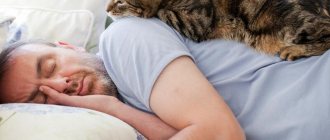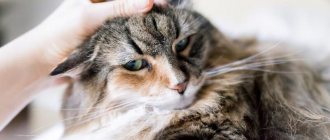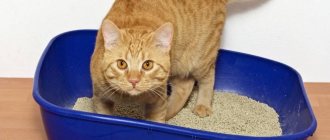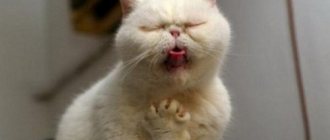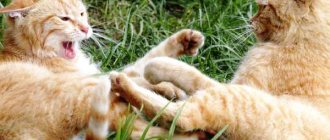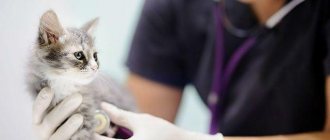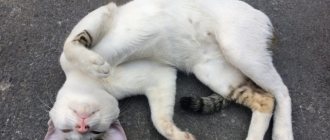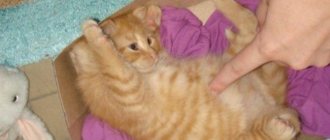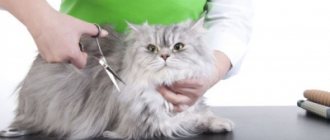A cat walking in circles may need your attention. This is a common cat greeting, especially if it is followed by rolling on the floor. There are also health problems that can lead to circling in cats.
Your cat may be walking in circles due to vestibular disease, a condition that affects the inner ear. This condition will disappear after 24 hours. Check for hypertension, hypoglycemia, and inner ear infection. If a cat circles after a head injury, perhaps due to a fall, it may suffer a concussion. Older cats may become dizzy due to dementia, a condition that causes significant confusion and disorientation.
A cat circling around you could be a sign that your cat is really happy to see you, or that she is just joking. However, it is important to note other unusual behaviors that your cat has not previously exhibited.
Why can a cat walk in circles?
Every owner needs to understand that if a cat starts walking in circles, then this is a fairly serious symptom and should under no circumstances be ignored.
The reasons for this behavior may vary. The most harmless of them are worms. In this case, the animal demonstrates restless behavior at night, can take multiple walks along the same route, but its coordination is not impaired and during the day it behaves more calmly. In this case, a regular anthelmintic purchased at a veterinary pharmacy will help. shutterstock
But it happens that walking in circles is accompanied by other, more serious symptoms, such as:
- impaired coordination;
- loss of appetite;
- twitching of limbs;
- legs give way;
- tongue hanging out.
All these unpleasant signs indicate that the animal’s nervous system has been damaged. Most often, older animals suffer from such problems, but occasionally symptoms can also be observed in young ones. The cat walks clockwise or counterclockwise, sometimes it can bump into walls, or fall to the floor and kick its feet.
The main possible causes of such disorders on the part of the central nervous system can be identified:
- a brain tumor;
- stroke;
- toxoplasmosis;
- otitis;
- high blood pressure.
The latter option most often occurs in cats with kidney failure and can lead to stroke, so cats with chronic kidney disease should undergo periodic veterinary monitoring and receive appropriate treatment
If kidney problems have been going on for more than a year, such an animal should be treated with increased attention. If the case is advanced, the cat walks in circles and its condition becomes worse, the situation may end in failure
shutterstock
General group of symptoms for all types
The disease has species-typical and generally similar symptoms. The different symptoms depend on the causes. All types of pathology are characterized by:
- the cat holds its head atypically, it can tilt it to the side or lower it down;
- a staggering gait is observed, the animal loses coordination, the cat can walk, raising its hind legs high.
Epilepsy in cats: symptoms, treatment, how to stop seizures
If the animal's spinal cord is damaged, it will experience pain when walking. Such cats try to hide in a quiet place and move less.
Attention! In severe forms, paralysis of the hind limbs can develop in cats.
With cerebellar ataxia, tremor occurs when running or walking. The kitten will often tremble, and most often the trembling is noticeable only in the back of the body. The cat also has dilated pupils and poor coordination.
If the vestibular apparatus is affected, the cat will suffer from severe headaches. Such animals constantly meow, hide in the corner, pressing their foreheads against the wall.
Hind limb paralysis
Symptoms and diagnosis
In general, the symptoms of ataxia in cats are simple. The pet looks like a drunkard, he shakes, the cat cannot walk normally, in severe cases he falls on his side with a roar, just trying to sit down. A constant tilt of the head to one side, as well as erratic circular eye movements, are very typical. Other symptoms may vary depending on the underlying cause of the ataxia. For example, a cat “under mint” can walk with a wobbling gait with its head held high; from time to time, it shakes it and generously splashes saliva around. It looks terrible, but goes away quickly.
Your veterinarian will perform a complete physical examination of your cat.
The information provided by the cat's owner is important. It is advisable to remember the following:
Did the animal have access to household chemicals, poisons, or was deratization (rodent extermination) carried out in your home or area?
Is there any information in your pet’s pedigree about any pathologies that the cat’s parents suffered from?
Did the cat fall from the balcony, did it get hit by a bicycle, etc.
It is very important to remember all the cases of illness that your pet has suffered. It is advisable to tell us if you have tried to treat it yourself by “prescribing” any medications
Treatment of SCD
Treatment depends on the disease, this is understandable. What to do with “feline Alzheimer”?
Alas, while dogs diagnosed with SCD have been treated with medication (L-deprenyl is a drug used for people with Parkinson's disease), and then only in the USA and Canada, there are no approved medications for cats (some human remedies sometimes give positive results, but everything is still at the experimental stage).
Changing your diet may help. Ideally, food for older cats should contain antioxidants (a set of vitamins C, E and beta-carotene), essential fatty acids, as well as chondroprotectors (methionine, glucosamine, chondroitin) and the amino acids L-carnitine and lysine.
Someday!... In the meantime, we can offer our wards all possible treatment, comfort, peace, good food, and, most importantly, our love and care. Let our pets age gracefully!
The phenomenon when a cat walks and falls, rolling over on its side, is not so rare. Unfortunately, not everyone and does not always know what is happening and how they can help. In fact, there are not so many pathologies in which such a symptom manifests itself.
Behavioral and visual signs of illness
Against the backdrop of all the advantages, we should not forget that cats are quite secretive and often neglect their own health so as not to appear weak.
Sleep duration
The first unmistakable sign that a cat is feeling unwell is prolonged sleep. The problem is that even when healthy cats sleep up to 18 hours a day. The duration of sleep may increase depending on weather conditions, type of feeding and care. If your pet begins to sleep much more, but you do not notice other symptoms of illness, keep his condition under control for at least a few days.
Unusually long sleep may be a sign of chronic fatigue or lack of energy. Poor health can be associated with both illness and metabolic disorders. In the autumn-spring period, there is a high risk of developing vitamin deficiency or mineral deficiency, which leads to increased fatigue.
Base temperature
The next true indicator of a cat’s well-being is its base body temperature. The cat's body temperature is measured only rectally. Normally, the temperature can range from 38 to 39.5 degrees. Statistically, the normal temperature is 38.5 degrees.
Most cats' body temperature varies throughout the day. Typically, a temperature increase of 0.5–1 degrees occurs in the evening. Temperatures between 39 and 41 degrees are considered a sign of fever.
When the body temperature rises, the cat usually sleeps more, refuses food, but drinks willingly. A sharply dull coat may indicate a fever. If the cat is not active, against the background of high body temperature, dry nose is observed. Ears that are too hot sometimes indicate an increase in temperature.
Problems with urination
Symptoms of illness include problems with bowel movements and urination. A cat that is sick may experience diarrhea or constipation; by the way, these conditions can alternate.
You should be wary if mucus or blood clots are found in the stool. Difficulty or too frequent urination is also considered a warning sign.
Problems with urination may be indicated by a cat’s reluctance to go to the litter box; this sign is especially often observed in males. You may notice that your cat is squatting many times in an attempt to empty its bladder, but no urine is being released. The animal may behave anxiously, screaming, digging or hiding.
Change in appetite
A change in appetite may indicate your pet's poor health. Fasting for 24 hours in some cases is natural, since cats tend to periodically “unload” the body.
Too much hunting for food can also indicate health problems. Uncontrollable hunger is usually caused by parasites, vitamin deficiency or other metabolic problems. An increase in appetite can be considered natural in the autumn, when cats actively gain weight before wintering.
Dehydration is one of the obvious and very accurate signs of poor cat health. By the way, dehydration can develop against the background of normal water consumption. Quite a lot of diseases provoke increased thirst, for example, some types of infections, kidney diseases and hormonal disorders.
Carefully take your pet by the withers (skin between the shoulder blades), pull up, turn a little and release. When dehydrated, the skin will remain in an unnatural position for some time.
If the skin returns to its normal position within a few seconds, it is too early to talk about dehydration.
Weight loss
With most illnesses, cats refuse to eat and rapidly lose weight. To record changes in your pet's weight, it must be weighed regularly. Sudden loss of muscle mass always signals problems.
In addition to fixing the weight, you need to pay attention to the silhouette of the cat. If metabolic processes are disrupted, the animal may suffer from edema, which will give false weight readings
With internal edema, the cat visually loses weight, its silhouette is distorted, but the weight remains the same.
When a cat is sick, the body redirects all resources to eliminate problems. At the same time, non-vital organs are deprived of their usual nutrition.
Even with minor illnesses in cats, the quality of their coat sharply deteriorates. The coat of a healthy animal looks shiny and silky. If you notice that your cat’s guard hair has become dry, is breaking a lot, bristling, or has lost its shine, carefully monitor your pet’s condition, most likely he is not feeling well.
What's wrong with the cat? the cat falls...
The cat usually still manages to get up, but its appearance makes a depressing impression. Although her vision is fine, her eyes make strange sudden movements, her head is unnaturally tilted to the side. After taking a few steps, the animal leans on its side and falls. Such disturbances are a sign that the cat has disorders of the vestibular system.
Problems with the vestibular system can be temporary - caused by malfunctions of the nerves and other organs responsible for the sense of balance and coordination of head and eye movements. In such cases, the frightening manifestations of disturbances usually do not last long and, ultimately, pass without consequences. In some cases, however, signs of a vestibular disorder may be symptoms of more serious diseases.
, so you should immediately contact your veterinarian for advice.
The main components of the cat's vestibular system are located in two interconnected areas. The first is the vestibular apparatus, located deep inside the inner ear, in the part adjacent to the cochlea. The second is in the lower part of the medulla, which is located at the top of the spine. The vestibular apparatus consists of several fluid-filled canals that contain specialized nerve cells and receptors.
These receptors, associated with the nerves leading to the medulla, respond to the movements of the fluid located in the chambers. When the position of the cat's head changes, the fluid shifts and sends signals about this to the brain. The brain, processing the received information, determines the position of the head relative to the horizon. The vestibular system allows the cat to always know whether its head is stationary or in motion, and, if its head is moving, in which direction. This allows the cat to maintain balance by controlling movements that compensate for changes in position in space. If a cat changes the direction of its movement, a signal about this will immediately be transmitted to the muscles of that side of the body, which should level out the resulting tilt and protect the animal from falling.
The most common clinical signs of vestibular disorders
are moving in a circle or falling to one side, pronounced tilt of the head and nystagmus (fast involuntary oscillatory movements of the eyeballs). In the presence of tumors or inflammatory diseases of the inner or middle ear, deformations (sagging) of the face are possible, since the facial nerves are closely connected to the middle ear, located next to the inner ear.
Diseases that lead to disruption of the vestibular system
, can vary significantly in severity. Causes include, for example, bacterial infections, inflammation, adverse reactions to certain medications, including some antibiotics, and a variety of neoplasms such as polyps, tumors, cysts, and cancer. In most cases, however, the cause of vestibular disorders cannot be identified. Such disorders are described as idiopathic vestibular syndrome.
Clinical signs of this mysterious disorder can be observed in both male and female cats, and can occur in cats of any age and breed. Although the symptoms of vestibular syndrome
usually do not differ from the symptoms of other types of peripheral vestibular diseases, they are temporary, appear abruptly, then gradually disappear within a few days. Most cats recover completely within two to three weeks. Although vestibular syndrome is not very common, any veterinarian encounters it from time to time in his practice.
Diagnosis of vestibular dysfunction
requires a thorough medical history and physical examination of the cat, including neurological tests and an otoscopic examination, in which the cat's ears are checked for signs of infection, inflammation, or tumors.
Treatment of vestibular disorders
selected depending on their cause. If the disease is secondary to infection, tumor or poisoning, treatment of the primary disease is required. In the case of idiopathic vestibular syndrome, there is no specific treatment yet. The animal must be kept in a safe place where the cat cannot be injured. Supportive care may include assisted feeding and fluid administration if the cat is unable to eat and drink on its own. Antiemetic medications may be used for nausea. In most cases, signs of idiopathic vestibular syndrome disappear within a short time and never recur.
Ear infections
Cat ear infections usually affect the outer ear. These infections are most often caused by ear mites. The most common symptom of mites is discharge from the ear along with scratching. Additionally, mites can affect your cat's sense of balance.
In addition to discomfort, bacterial inflammation can spread to the inner ear. This is known as otitis externa and can become an irreversible problem. In addition to whirling, internal otitis media has the following symptoms:
- Drooling from one side of the mouth
- Anisocoria (uneven pupil size)
- Dryness in one eye
- Lack of depth perception
- Lack of motor coordination leading to inability to eat
- Vomit
If left untreated, the bacteria that causes otitis externa can cause permanent damage. The cat may never regain the ability to walk upright. The infection can also spread, causing difficulty breathing and rapid heartbeat. Permanent hearing loss in the affected ear is also a risk.
Otitis media can be treated with bacterial ear drops that are placed directly into the ear. Do not over-clean your cat's ears, as this may cause permanent damage to the eardrum.
Types of seizures
Regardless of the cause, all seizures can be divided into two large categories: local and generalized (generalized). Let's consider these options in more detail.
Generalized seizures
They are easiest to identify even for the most inexperienced owner: in such cases the cat can simply fall, shaking all its limbs, it is clear that the animal is in a semi-conscious state. In many cases, severe tremor of the facial muscles is observed, drooling profusely, and involuntary urination and defecation are observed.
As a rule, generalized convulsions rarely last more than three minutes. More precisely, cats rarely survive longer attacks. In many diseases (more precisely, in their first stages), soon after convulsions the animal fully recovers and often behaves as if nothing had happened. Rapid breathing will indicate what has happened.
In other cases, immediately after an attack, the animal looks confused, depressed, and may behave inappropriately for some time. During this period, it is very desirable to provide the pet with complete peace and absence of stress, since any negative environmental factors can provoke a repeat attack.
Local convulsions
They are more typical for cats (if we compare them with dogs). Seizures in this case can be very difficult to detect. The problem is that not in all cases the cat’s hind legs (or forelimbs) actively twitch. Everything is much more complicated.
As in the previous case, cats may experience a sharp increase in salivation, foam at the mouth, twitching of the eyelids or facial muscles, excessive vocalization (the cat constantly and loudly screams), as well as strange and abnormal movements of the head and/or limbs.
In severe illnesses, seizures gradually progress to generalized ones, but situations are more common when their frequency and duration increase (first the front legs twitch, and then all the limbs).
Let us note that even experienced veterinarians are not always able to determine the root cause of seizures if the appearance of the latter is caused by some difficult to diagnose pathologies of the nervous system. In such situations, encephalography is vital. This technique (expensive and rarely used in veterinary medicine) helps to accurately determine the state of the animal's brain.
But! It happens that seizures are not a sign of some serious pathology. Let's give a simple example. Cats, of course, cannot be considered avid swimmers, but sometimes they have to be washed, or the animal ends up in a deep puddle. Local “twitching” after bathing is a relatively normal phenomenon. This happens even to professional swimmers. Treated with peace and rest.
Primary and secondary seizures
Other veterinarians prefer to divide seizures differently: also into two types, but they are guided by the root cause and time of their occurrence. In this case, all seizures are divided into primary and secondary.
The latter are found much more often than the primary ones in veterinary practice. Simply put, secondary seizures are a consequence of some serious illness acquired by the cat during its life. These include: brain tumors, inflammation or infections (encephalitis), consequences of injuries, strokes (yes, they happen in animals too). Secondary status is indicated by the presence of other signs of the disease, such as vomiting, diarrhea, an increase or sharp decrease in body temperature, etc.
With primary seizures, they are also not the disease itself, but indicate severe functional disorders of nervous activity. In particular, persistent and unexplained seizures (which are not, however, epileptic) may indicate an imbalance between the number of “excited” and “inhibited” neurons in the brain, or some problems with the volume of neurotransmitters produced by the body.
In such cases, the first seizures are observed from an early age. However, such animals usually do not live to a relatively mature age. It is believed that no more than 29% are primary. As a rule, all diseases that cause their appearance are genetically determined and are not always diagnosed (due to the lack of appropriate technical equipment).
What should a person do?
If a cat crumples a blanket, a bed or a person with its front paws, this means that it is showing its love, care and affection. The cat comes to share its energy and absorb everything negative. Therefore, it is not worth punishing, shouting or beating animals for such manifestations. Otherwise, the animal will close down, become aggressive and may even begin to take revenge.
If a cat wrinkles a blanket or clothes, purrs and at the same time releases its claws, you should take care of their length. Owners can also resort to other tricks:
- Stroke your pet's paws from above, which will make him hide his claws;
- Place a thick blanket or pillow under the cat's paws;
- While stroking the cat's head, place the cat on its side or back, which will change the force of the impact;
- Distract your cat's attention with a soft toy.
In any case, such actions, especially the soft massage and purring of the cat, speak of his deep feelings, affection and love for the person. But the theory of zoologists that cats are ways to treat humans deserves special attention.
Felinotherapy is a special, therapeutic technique that can be used by anyone who is not allergic to wool. Another interesting ability of animals is to sense a person’s mood and problems. Because of this, the pet can independently come to the rescue and relieve stress. You should not refuse such attention, because the purring of a cat relieves stress and tension and calms the nervous system.
By the way, the purring of a cat helps to thicken the bones, which they use to heal fractures. This is due to the fact that the vibration frequency of sound is from 20 to 50 Hz, which has a good effect on the condition of bone tissue.
Due to the positive effects of purring and cat massage, animals are used to treat schizophrenia, cerebral palsy and autism.
What not to do when a cat tramples a blanket with its front paws:
- Scold and shout;
- Beat and use physical violence;
- Trim nails too short;
- Limit the animal’s impulses to show tenderness and care;
- Abort a cat if she is in heat.
It is necessary to appreciate such animal impulses as the desire to trample the blanket with its paws and massage the owner. Because there are a number of understandable reasons for this, starting with innate instincts and ending with a state of excitement during estrus. There is no need to limit such behavior, and especially not to scold and beat the cat. All you need to do is use a few simple techniques and trim your nails. In addition, paw massage will help relieve tension, relieve pain and even some diseases. Not to mention the charge of positive emotions.
We often see cats kneading the blanket with their paws or sitting on our stomach and starting to trample on it. This behavior is caused by the instinct of a pet, memories from childhood, psychological relaxation, the desire to make sure of the safety and comfort of the place, mating season or care, an expression of love.
Watch the video why cats knead their paws on our Youtube channel Mr. Cat:
Why does a cat fall over on its side when walking: reasons
However, the list of medications for each case is individual, and the veterinarian draws it up based on the diagnosis. The same goes for aftercare.
Most neurologists recommend examinations every two weeks to monitor the progress of treatment. Secondary symptoms such as vomiting and dehydration should also not be ignored. Experience shows that cats recover faster after diseases of the peripheral nervous system.
Prevention of "shifty" eyes
It is impossible to formulate a specific system of preventive measures for nystagmus, because There are many reasons, including congenitality. The only thing we can advise is to avoid poisoning your cat with lead and other toxins. In addition to Siamese cats, cats with albinism are predisposed to this disease, keep this in mind. Some kittens under one year of age may exhibit nystagmus, but this is very rare and will go away soon.
Category Cat diseases.
Ataxia in cats is a pathology of motor activity characterized by a lack of coordination of muscle movements, coordination and loss of orientation in space.
Most often it is genetic in nature, but can be acquired as a result of a severe form of group B hypovitaminosis or cerebellar injury. What is characteristic is that the animal remains strong, it is simply more difficult for him to maintain balance and the sequence of each action.
This neurological disorder does not have any age, breed or gender restrictions and can be diagnosed almost from birth, as soon as the kitten begins to move. It is practically incurable.
Old cat syndrome
How old is your pet? Ten? More? Then this is definitely the place for you! Because after 8-10 years, various age-related changes begin to occur in the cat’s body, which you need to be aware of and take into account. May your four-legged pet live happily ever after!
By the way, previously the age limit for our pets was much lower - 12-year-old cats were considered long-livers. It was man who raised the quality of life, and with it its duration, by one and a half to two times.
And now it is easy to meet cats that have reached 16-19 years of age, or even more. For example, in our clinic we see two cats, each 21 years old, and the most significant thing that worries them is their teeth, or rather, tartar, which is removed from them from time to time.
So, among pets, the number of “elderly” pets (approximately 30%) who need optimal care is increasing.
It is a fact that with the increase in the number of years lived, everything changes (and not only for cats :-)). Age-related changes affect all body functions. For now, we will consider only behavioral ones.
The causes of behavioral changes can be a number of diseases (including systemic ones) acquired by the animal over the years of its life, brain pathologies, as well as CDS - cognitive dysfunction syndrome. First, let's look at medical ailments, and then move on to the most interesting part.
Osteoarthritis (joint disease) can occur in 65% of cats over 12 years of age (the elbow and hip joints are most commonly affected, and the knee and shoulder are less common). Joint pain leads to decreased mobility and the appearance of aggressiveness when communicating with people and other animals.
Systemic hypertension (high blood pressure) often causes a pet to scream at night, become disoriented in space, lose consciousness, senseless circular movements and
We recommend reading: Signs of Ear Mites in Dogs With Photos
Source
Reasons provoked by third-party factors
Initially, it is worth considering the reasons for frequent and ineffective urination, which are caused by external factors. That is, in this case there is no need to talk about any disease. Such factors can theoretically provoke the development of a certain pathology, but this is only if measures are not taken in a timely manner to eliminate it.
| Possible reason | Description |
| Drinking excessive amounts of liquid. | Roughly speaking, the body mistakes any liquid that enters the body for water - this is not only water, but also various teas, coffee, cocoa, etc., juices, cocktails, dairy products and much more. It is recommended to consume 1.5-2.5 liters of liquid in any form per day. If there is a lot of it, then the result will be appropriate - frequent visits to the toilet. Little urine may be produced due to the fact that the nerve endings will be greatly irritated by constant stretching. |
| Poor nutrition | If you overuse meat, as well as salty and spicy foods, this will lead to gradual oxidation of urine. Too acidic urine negatively affects the condition of the bladder tissue, causing irritation, which leads to an increase in the number of urges. |
| Taking medications | Everything is very simple here - a number of medications have a pronounced or hidden diuretic effect. This applies not only to those drugs that are prescribed to treat diseases of the urinary system, but also to those that are used to treat the heart, liver and other internal organs. |
| Pregnancy | In the early stages, the body tries in every possible way to protect itself. Therefore, it stimulates the bladder to empty itself as often as possible by sending appropriate signals to the nerve endings. Thanks to this, urine does not stagnate, all toxins and impurities are eliminated faster. In later stages, the problem of frequent urination with a small amount of urine is due to the fact that the uterus, which has significantly increased in size, begins to put pressure on the bladder. |
| Iron deficiency | Anemia is a blood disease, however, it can be attributed to third-party factors, since the disease does not affect the genitourinary system. With iron deficiency, organ tissue becomes more vulnerable to damage and irritation. It is this fact that can explain the increase in the number of false calls. |
To improve your condition, you need to eliminate all of the above factors. If the problem is pregnancy, the woman has no choice but to simply wait - after childbirth the situation should normalize. If the problem does not disappear, most likely the problem is due to some kind of disease or the presence of pathology.
Causes of pain
If a back injury occurs, which could occur during a fight with other cats, an accident involving him, or an unfortunate fall, then you should limit his activity and immediately take him to the veterinarian. Even a small wound can cause severe torment and pain not only in the area of the base of the tail.
Also, a similar condition, when a cat has pain near the tail, will cause a tumor. In this case, the cat’s behavior will become passive and lethargic, and when you start stroking it, it may meow pitifully or begin to hiss. This will happen because you may have touched a sore spot.
There is a possibility that the cat was already born with some defects in the back and base of the tail. Nowadays this is not uncommon, because the cold-blooded and reckless attitude towards cats of breeders who, for their own benefit, cross certain types of different breeds, leads to mutations of the spine, muscles and ligament rupture. In the event of a ligament rupture, severe pain occurs, which can be prevented by wearing a special bandage. He will record the position throughout the year if the diagnosis is confirmed.
Uncomfortable sensations cause joint disease. Most often, this disease is hereditary and other symptoms appear. There may also be pain in the paws, and the tail will always be down and motionless.
Treatment Basics
Be that as it may, the treatment of ataxia in cats depends purely on the reasons that caused pathological changes in the animal’s behavior. In case of poisoning
It is important to determine what exactly the animal was poisoned with. In all cases, activated carbon is prescribed, which partially absorbs the toxin, and intravenous administration of supporting compounds is practiced.
If the reasons for a cat’s somewhat inappropriate behavior lie in a “dose” of catnip or valerian
, there is no need to worry: within a few minutes the effect of the substances will end and the animal will become normal again.
For traumatic brain injuries
or even suspicions about them, you need to urgently take the cat to the veterinarian. He will assess the condition of the animal. If the brain has been damaged, there is a high probability of death, or the animal turning into a “vegetable”. In this case, euthanasia is recommended. In other cases, emergency surgery can save the cat. Similarly - in cases of back injuries, which may in one way or another threaten the integrity of the spinal cord.
Thiamine deficiency
, which is detected using a biochemical blood test, is eliminated by a balanced diet and the exclusion of foods containing thiaminase from the diet. In severe cases, vitamin B1 injections and oral multivitamin preparations may be necessary.
Why does a cat take the owner's place?
If a cat lives in the house, then its owner cannot help but notice some peculiarities in the behavior of his animal. Cats and cats can surprise; they give rise to a lot of questions and superstitions. If a person is about to sit down on a chair, then the cat is right there. The pet jumps onto the chair right in front of the owner's nose.
It seems that the pet is doing this on purpose, as if he wants to demonstrate his leadership and audacity. The owner at this moment usually adjusts and does not interfere. However, the situation is somewhat different. The cat tries to take exactly the place of the owner, since the elusive smell of a person remains there. Cats have a keen sense of smell.
The pet expresses the mood to be close to its owner. The same thing happens when a cat goes to sleep on its owner's clothes.
After the owner gets up from the chair, the seat retains heat for some time. A soft, warm chair that also retains its owner's scent is a great place to sleep.
If a feline jumps onto a chair before the owner sits down, this is a sign that the pet is attracting attention. You need to try to give the animal a little of your time, chat, scratch the cat behind the ear
Mozilla/5.0 (Windows NT 6.3; Win64; x64) AppleWebKit/537.36 (KHTML, like Gecko) Chrome/81.0.4044.122 Safari/537.36
Therapeutic effects on humans
According to professional breeders, pets are capable of healing. This theory is partly true. It has been scientifically proven that they can help a person.
Treatment with cats or feline therapy is a therapeutic technique that anyone can resort to if they are not allergic to wool. Cats are able to sense the owner’s mood; if treated gently, he will come to the rescue when you need to relieve tension.
In addition to the fact that cats help you feel better, their purring calms the human nervous system.
However, rumbling has another function - thickening the bones. Pets use it to heal fractures, since the frequency of sound vibrations from 20 to 50 Hz has a positive effect on bone tissue.
Doctors recommend communication with cats for people diagnosed with schizophrenia, cerebral palsy, and autism. Regular communication will help in socialization of children, becoming a good friend. The care shown by pets normalizes the human condition.
Requirements
Why does the kitten meow constantly? In addition to the options already listed, there are several more. For example, if a cat demands something
The most important thing is to attract attention to yourself. This is exactly what the animal does
Only in this case does it clearly indicate that it wants something. And this is far from the attention of the owner.
Try closing the door in front of the cat, leaving him on the other side of the room. Most likely, the animal will begin to express its displeasure. Moreover, demand to open the door. How is this expressed? Meowing. Moreover, loud, clear and intrusive. And also scratching.
This is also quite normal. Everyone somehow expresses their dissatisfaction and asks for something, right? Cats have a wonderful tool for this: meowing. How to determine exactly what is wrong? Listen to the tone of the sounds your pet makes. If he is indignant, the animal demands something.
Greetings
Often a cat that walks in circles is simply happy to see its owner. If your cat circles you when you get home, stop and enjoy the attention. A cat offering this greeting will likely exhibit this additional behavior.
- Tail curled up and pointing at you
- The cat will try to rub its head against your shins and legs.
- Will roll over on his back
- Verbalization
Basically, the cat wants to be acknowledged and petted a little. The spinning usually stops after a few seconds. Otherwise, the cat still wants something from you. Usually it's either food or play.
How to understand a cat: a guide to moods
These clues will help you understand what your cat is currently feeling and what mood she is in.
Lill Chin
Satisfied: sitting or lying down, eyes half-closed, pupils constricted, tail almost motionless, ears directed forward, purring. A very happy cat will often stomp her paws on a soft surface, such as your lap.
Playful: ears pointed forward, tail raised, pupils slightly dilated (play is a type of hunting behavior).
Irritated or overexcited: Pupils dilated, ears turned back, tail wagging or quivering, may make threatening warning sounds and may bite. After active play, many cats quickly become overexcited, go into a rage and begin to attack, bite and scratch.
Nervous or anxious: ears pointed to the sides or back, pupils dilated, tail down or tucked. The cat walks half-bent, pressing against the floor, looking for shelter. In this state, the cat may sit facing the wall so as not to see the outside world.
Frightened or shocked: ears point back, pressed against the head, whiskers pressed to the muzzle, back arched, fur standing on end, tail raised or lowered. The cat may howl, growl, hiss and spit.
Defends itself: the body is bent, the ears are parallel to the head, the mustache is pressed to the muzzle, the tail is held between the legs or wrapped around the body, the pupils are dilated. The cat meows loudly, howls, hisses or spits.
Angry, aggressive: ears are laid back, pupils are extremely constricted, the tail can be raised or lowered, the fur stands up. An aggressive cat stares unblinkingly at its opponent and growls or howls until it retreats.
Cats do not like to fight and prefer to intimidate each other, but if the opponent does not give up, there will be a fight.
Prevention
When planning mating, it is recommended to check the health of the female and male. Adult cats should be protected from injury and poisoning. As a preventive measure, it is necessary to maintain a high level of immunity, monitor the quality of nutrition, and promptly treat viral and infectious diseases. If a kitten or adult cat exhibits symptoms of ataxia, you should not self-medicate or expect the condition to normalize on its own. Sometimes vestibular disorders can be the result of dangerous internal pathologies, the timely treatment of which affects prognosis and recovery.
Diagnosis of ataxia in a cat
The main stage in diagnosing pathology is a complete history taking. The veterinarian must determine whether the animal had injuries or whether it suffered from infectious diseases. If possible, find out information about heredity and the course of pregnancy if we are talking about pathology in a kitten.
The animal's nervous system is assessed and tests are taken to identify viral pathogens. It is recommended to do an MRI of the brain to see tumors or areas of bruising. It is necessary to examine the ears using an otoscope.
As soon as there is a suspicion that infection is occurring in the area of the brain or spinal cord, a test for leukocytes in the cerebrospinal fluid is required.
Diagnosing disease in pets
